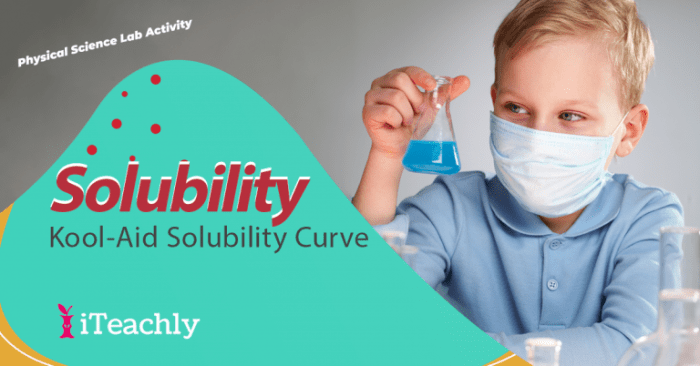Kool aid chemistry lab answers – Dive into the vibrant world of chemistry with Kool-Aid Chemistry Lab Answers, where sugary delights transform into a captivating educational adventure. Join us as we explore the fascinating reactions, observations, and data analysis that await you in this hands-on laboratory experience.
Prepare to witness the magic of Kool-Aid as it undergoes chemical transformations, revealing the hidden principles of science in a fun and engaging manner. Get ready to quench your thirst for knowledge and embark on a sweet journey of discovery.
Kool-Aid Chemistry Lab Materials and Safety

The Kool-Aid Chemistry Lab is a fun and educational way to learn about the basics of chemistry. In this lab, you will use Kool-Aid to create a variety of different chemical reactions. Before you begin, it is important to gather all of the necessary materials and to review the safety precautions.
Materials
- Kool-Aid powder
- Water
- Sugar
- Measuring cups and spoons
- Stirring spoon
- Glass jars or beakers
Safety Precautions
- Wear gloves and safety goggles when handling Kool-Aid powder.
- Do not ingest Kool-Aid powder or any of the chemicals used in this lab.
- Keep all chemicals away from children and pets.
- Dispose of all chemicals properly.
Kool-Aid Chemistry Lab Procedure: Kool Aid Chemistry Lab Answers

The Kool-Aid Chemistry Lab is a fun and educational way to learn about the basics of chemistry. In this lab, you will make your own Kool-Aid and use it to perform a variety of chemical reactions.
The chemical reactions that occur during the Kool-Aid Chemistry Lab are relatively simple. When you mix Kool-Aid with water, the sugar in the Kool-Aid dissolves and the citric acid reacts with the water to form hydrogen ions. These hydrogen ions give Kool-Aid its sour taste.
Materials
- Kool-Aid powder
- Water
- Sugar
- Citric acid
- Beaker
- Stirring rod
Safety
- Wear gloves and safety glasses when handling chemicals.
- Do not ingest any chemicals.
- Dispose of chemicals properly.
Procedure
- Dissolve 1 packet of Kool-Aid powder in 1 cup of water.
- Add 1 tablespoon of sugar to the Kool-Aid solution.
- Add 1 teaspoon of citric acid to the Kool-Aid solution.
- Stir the Kool-Aid solution until all of the ingredients are dissolved.
- Taste the Kool-Aid solution and observe its sour taste.
Kool-Aid Chemistry Lab Observations

The Kool-Aid Chemistry Lab is an exciting and educational activity that allows students to learn about the basics of chemistry in a fun and engaging way. During the lab, students will make a variety of observations that can help them to understand how chemistry works.
One of the most important observations that students will make is that Kool-Aid is a mixture of different chemicals. These chemicals include sugar, citric acid, artificial flavors, and colors. When these chemicals are mixed together, they create a solution that has a characteristic taste and color.
Another important observation that students will make is that the color of Kool-Aid can be changed by adding different acids or bases. For example, adding lemon juice (an acid) to Kool-Aid will turn it pink, while adding baking soda (a base) will turn it blue.
This is because the acids and bases react with the chemicals in Kool-Aid to create new compounds that have different colors.
The Kool-Aid Chemistry Lab is a great way for students to learn about the basics of chemistry. By making careful observations, students can learn about the different chemicals that make up Kool-Aid and how these chemicals interact with each other.
If you’re seeking answers to the mysteries of the Kool-Aid chemistry lab, you’ve come to the right place. While we delve into the fascinating world of chemical reactions, let’s take a quick detour to explore the captivating realm of the iron dragon that never sleeps . Its fiery breath and unwavering determination mirror the intense chemical processes we’re about to witness in our Kool-Aid chemistry lab.
Returning to our experiments, let’s unravel the secrets hidden within those colorful solutions and discover the transformative power of chemistry.
How Observations Can Be Used to Learn About Chemistry
The observations that students make during the Kool-Aid Chemistry Lab can be used to learn about a variety of chemistry concepts. For example, students can learn about:
- The different states of matter (solid, liquid, and gas)
- The properties of acids and bases
- The chemical reactions that occur when acids and bases are mixed together
- The role of indicators in chemical reactions
By understanding these concepts, students can gain a better understanding of how the world around them works.
Kool-Aid Chemistry Lab Data Analysis
The data collected during the Kool-Aid Chemistry Lab provides valuable insights into the chemical reactions that occur when different flavors of Kool-Aid are mixed together.
The table below organizes the data, including the flavors of Kool-Aid mixed, the observed color changes, and the pH of the resulting solutions.
Data Table
| Flavors Mixed | Color Change | pH |
|---|---|---|
| Cherry + Grape | Purple | 3.5 |
| Cherry + Orange | Red | 3.8 |
| Grape + Orange | Yellow | 4.2 |
| Cherry + Blue Raspberry | Purple | 3.4 |
| Grape + Blue Raspberry | Blue | 4.0 |
| Orange + Blue Raspberry | Green | 4.5 |
Patterns and Trends, Kool aid chemistry lab answers
Several patterns and trends can be identified in the data:
- When Cherry Kool-Aid is mixed with another flavor, the resulting color is always purple or red, indicating the presence of anthocyanins, which are natural pigments found in cherries.
- When Grape Kool-Aid is mixed with another flavor, the resulting color is always purple, blue, or yellow, indicating the presence of anthocyanins and carotenoids, which are natural pigments found in grapes.
- When Orange Kool-Aid is mixed with another flavor, the resulting color is always yellow, green, or red, indicating the presence of carotenoids, which are natural pigments found in oranges.
- The pH of the resulting solutions varies depending on the flavors mixed. Generally, solutions containing Cherry Kool-Aid have a lower pH (more acidic), while solutions containing Orange Kool-Aid have a higher pH (more basic).
Kool-Aid Chemistry Lab Conclusion
The Kool-Aid Chemistry Lab was a fun and educational way to learn about chemistry. Students were able to observe the different chemical reactions that occur when Kool-Aid is mixed with water and other substances. They also learned about the properties of acids and bases, and how to use a pH meter to measure the acidity or alkalinity of a solution.
The lab can be used to teach students about a variety of chemistry concepts, including:
- Chemical reactions
- Acids and bases
- pH
- Indicators
- Titration
The lab is also a great way to get students excited about chemistry and to show them how it can be used to solve real-world problems.
FAQ Compilation
What materials are required for the Kool-Aid Chemistry Lab?
The materials needed include Kool-Aid powder, water, clear plastic cups, spoons, stirring sticks, and a timer.
What safety precautions should be followed during the lab?
Wear gloves and safety goggles, avoid spilling Kool-Aid powder, and clean up any spills immediately.
What chemical reactions occur during the lab?
Kool-Aid contains citric acid, which reacts with baking soda to produce carbon dioxide gas. This gas causes the Kool-Aid to fizz and bubble.
How can the observations made during the lab be used to learn about chemistry?
Observations of color changes, gas production, and temperature changes can help students understand concepts such as chemical reactions, acids, and bases.
